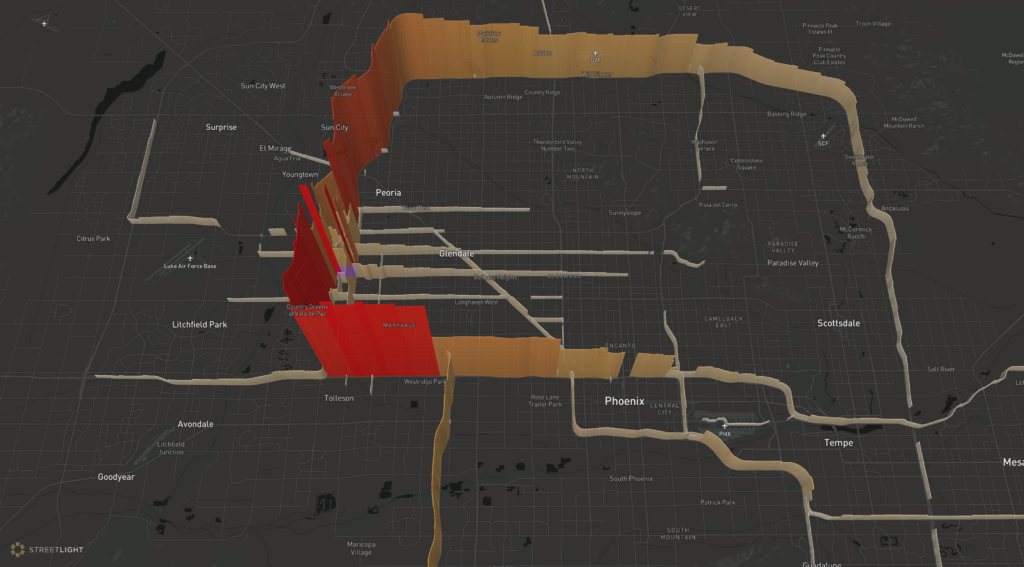Swift Streets? Ranking Stadiums for Traffic Management During Taylor Swift’s Eras Tour
Most stadiums saw traffic delays at least double during the Eras Tour, according to StreetLight’s data. But there were some notable outliers. At one stadium, traffic actually improved.

Jump Ahead
When Taylor Swift announced her first live tour since 2018, the rush on tickets by fans made national headlines (and earned a congressional hearing).
For transportation and transit agencies, and stadium operators, a very different challenge emerged: Managing traffic from the legions of fans who would descend on the stadiums for the Eras Tour.
Event operations pose a special challenge as they put a dramatic tax on roadway operations over a narrow time block, which local transportation infrastructure is not built to support during a typical day. As a result, stadium operations groups often work in close coordination with local transportation agencies to manage traffic, as well as ingress and egress from the stadium.
So when it comes to the Eras tour, how have the stadiums and agencies fared at managing fan traffic and keeping the roadways flowing? StreetLight ran the numbers to find out. Then, we look at how transportation and operations professionals can use analytics for more effective events traffic management.
Key Findings:
- Vehicle Hours of Delay (VHD) on roadways adjacent to the concert venues more than doubled at 7 out of 9 stadiums during the Eras Tour concerts. On average, vehicle delays increased 90% across all stadiums compared to delay hours at comparable times.
- NJ’s MetLife Stadium and Atlanta’s Mercedes-Benz Stadium, both of which invested heavily in transit for the concert, were the big traffic winners. Atlanta only saw traffic increase 32% on average around the stadium.
- Astonishingly, traffic around MetLife Stadium actually decreased compared to usual delays. This is the only stadium where traffic decreased.
- The worst stadium for increased traffic delays was Glendale, Arizona’s State Farm Stadium, where traffic congestion near the stadium was up 315% on average, followed by Arlington, Texas’ AT&T stadium, with traffic congestion up 288%.
- Las Vegas’ Allegiant Stadium was the absolute loser for average total delay hours during the concert series, at 2,613 hours. No other venue cracked 2,000 delay hours.
Eras Tour Traffic Winners & Losers
To understand the traffic impact from the Eras concerts between March and May, StreetLight analyzed all non-local roadway segments within 1 mile of each stadium between the peak arrival hour of 5-6pm on the day of each concert. (You can read more about StreetLight’s data here.) We then compared the Vehicle Hours of Delay (VHD) during that same hour and day of the week in the rest of the month. VHD measures the amount of time vehicles spend in congestion versus the time travel would take in free-flow conditions.
Overall, across all 9 stadiums and 25 concerts, average delay hours were 90% higher than typical. In fact, most stadiums saw delay hours at least double on average over the course of the concerts.

Two major success stories emerged, however: Atlanta’s Mercedes-Benz Stadium and New Jersey’s MetLife Stadium saw average delays well under 100%.
Atlanta only saw a 32% increase in traffic. But NJ’s MetLife Stadium was the real standout.
Transportation professionals in fact managed traffic so well that VHD actually decreased during the concerts, by 19% on average over the course of the three nights.Notably both Atlanta and New Jersey’s concert venues were given high marks for their emphasis on public transit options to the concert. Atlanta’s Metropolitan Rapid Transit Authority System (MARTA) reported seeing three times the usual ridership during the concert days at stations near the stadium, according to CBSNews. NJTransit, which ran extra service around the stadium, carried 80,000 riders via train and bus to the concert, according to NJ.com.
Philadelphia also placed a big emphasis on public transit. This paid off for the stadium on two of the concert nights. The Friday and Sunday shows in May at Philadelphia’s Lincoln Financial Stadium saw only about a 70% increase in delays, a comparatively good traffic performance.
However, on Saturday night Philadelphia’s Lincoln Stadium encountered huge snarls, with a 402% increase in hours of delay. This dragged down the stadium’s average across the three nights. It’s also a signal of how tenuous traffic management at an event like this can be, and how easy it is for delays to compound.
For worst overall increase in delays, the Phoenix area’s State Farm Stadium took first place, with delay hours up an average 315%. It was closely followed by Arlington, Texas’ AT&T’s Stadium where traffic rose by 288% on average.
However, by far the worst traffic nightmare occurred at the Sunday show in April at Arlington’s AT&T Stadium, when VHD increased by an incredible 847% from the same hour on a typical, non-concert day.

Of course, there is a vast difference in terms of the baseline of delay hours around each of these stadiums.
When looking at VHD in total, MetLife, located in the most populous region of the country, ranks as the most traffic-clogged on a typical non-concert day, with over 1,000 total hours of delay on average during the days and times studied. (Total VHD is impacted by the vehicle volumes, roadway types, and surrounding density of transportation infrastructure near the venues.) But as the data shows, investing in transit and other traffic mitigation strategies enabled major improvements.
On the flipside, Arlington Stadium is the least plagued by overall delays on a typical night. The stadium sees an average of 334 hours of delay during the 5-6pm hour on the same days of the week as the Swift concerts. During the Swift concerts that figure jumped to 1,296 hours.
For total VHD during the concert run, Las Vegas performed worst overall. Delay hours in Sin City rose to an average 2,613 hours during the concerts.
This is particularly interesting because StreetLight found that the city also saw the shortest trip distance to the concert, at only about 12 miles on average, compared to trip lengths of 25 miles on average across all other stadiums. (Trip distance was measured by vehicle trips starting and ending within the venue parking lots.) Las Vegas’ short trip distance is likely a reflection of the hotel infrastructure enabling people to stay close to the concert, and the city’s relative desert isolation.
But that didn’t stop traffic from snarling.
Although concert goers weren’t traveling far, the stadium’s location on the Strip likely had an impact here.

Solve congestion WITHOUT highway expansion
Get Congestion Solutions GuideHow Transportation, Events, & Operations Professionals Can Manage Event Traffic Better
Events like the hotly anticipated concerts of Swift’s Eras Tour test the limits of everyday traffic operations, and often demand temporary strategies that reduce congestion, encourage shared transportation modes, and keep concert-goers safe.
But anticipating and mitigating traffic issues from special events is far from simple. To minimize delays, promote smooth traffic flow, and ensure safety, planners and operators need to know which routes attendees will travel, the modes they will use on the way, the intersections where they’ll be turning, and what alternate routes people may take as primary routes become congested.
Complicating these challenges is the time and financial cost of gathering the right data needed to understand all these factors. While certain major arterials may benefit from permanent traffic counters, many roadways lack these counters, such as residential or other local roads that may experience cut-through traffic when larger roadways become gridlocked.
This makes it impossible to get historical data with the granularity needed to understand past events or even average seasonal roadway conditions. Meanwhile, collecting data on complex roundabouts, intersections, or weaving segments can also be difficult, even if manual counts or surveys are deployed in advance of the event.
Big Data and Special Events Traffic Planning
A big data approach to special events planning can help fill crucial data gaps to anticipate the traffic impact of special events. Whether it’s used to inform broader travel demand models or applied for analysis of traffic operations during specific events, access to on-demand transportation analytics expedites special events planning without needing to put staff in harm’s way for manual counts and surveys that only capture a snapshot of traffic during a short period of time.
This expedited process allows planners and operators to proactively evaluate alternative traffic management strategies and communicate their decisions with the public in advance of special events.
Moreover, analyzing Origin-Destination of traffic, and routing to and from event venues can be particularly difficult when using traditional data collection methods, but it can also be one of the best starting points to understanding where and why congestion hotspots occur while also revealing underutilized road segments that could be used to free up traffic.

Big data makes analyzing top routes quick and simple so that traffic operations managers or planners have the best tools to ensure traffic flows smoothly.
When analyzing historical traffic data for special events planning, the following metrics can be helpful:
- Origin-Destination (O-D) and Top Routes – to anticipate where attendees are coming from, which roadways can expect the largest increase in travelers, and which less-used segments could be candidates for traffic rerouting.
- Turning Movements – to understand where and when people turn into and near the event venue during typical conditions and special events.
- Traffic Volumes – to understand where roadways may reach capacity and identify potential detour routes.
- VHD – to anticipate the impact and severity of traffic congestion during special events compared to average conditions.
- Speed – to evaluate safety conditions and crash risk near the venue, especially for vulnerable road users like pedestrians and cyclists.
- Travel Time – to understand how special events impact not just attendees but other road users and communicate expected delays to the public.
- Bike and Pedestrian activity – to identify common walking and cycling routes to and from the venue.
- Transit ridership – to understand available capacity for shared transportation modes that can help ease congestion.

Planners and traffic engineers can use these metrics to anticipate how traffic conditions will change during special events and prioritize traffic management strategies that will keep traffic flowing and protect the safety of all road users.
For example, examining turning movements at key intersections leading to the event venue could inform temporary signal retiming on the day(s) of the event to offer more opportunities for attendees to make their turns toward the venue. Likewise, identifying increased traffic volumes on residential or other local streets not suited for high-volume traffic could signal the need for signage directing event attendees to preferred alternate routes toward the venue.
Traffic operations managers can now also leverage real-time or near real-time data to monitor traffic disruptions as they develop and compare current speed and volume conditions to historical data to diagnose slow-downs or safety concerns and how to deploy the best solution quickly. StreetLight’s Traffic Monitor product can equip agencies and firms with real-time insights for any road, even newly constructed roads and other roads without physical counters.
To learn how you can leverage big data for special event and other traffic operations management, check out our Traffic Engineering and Operations Solutions.

Get traffic flowing with nine data-driven congestion solutions
Get Congestion Solutions GuideReady to dive deeper and join the conversation?
Explore the resources listed above and don’t hesitate to reach out if you have any questions. We’re committed to fostering a collaborative community of transportation professionals dedicated to building a better future for our cities and communities.